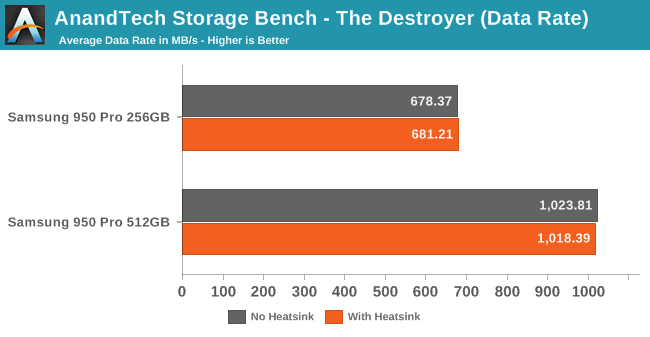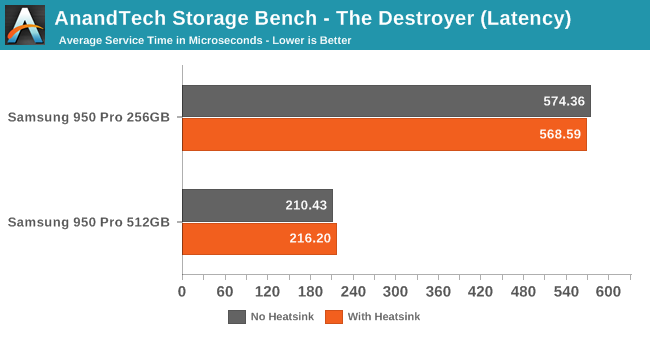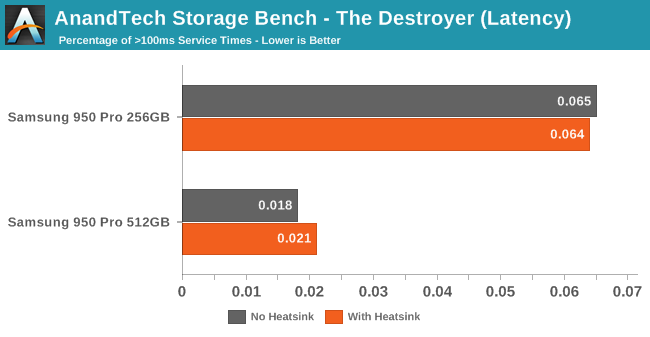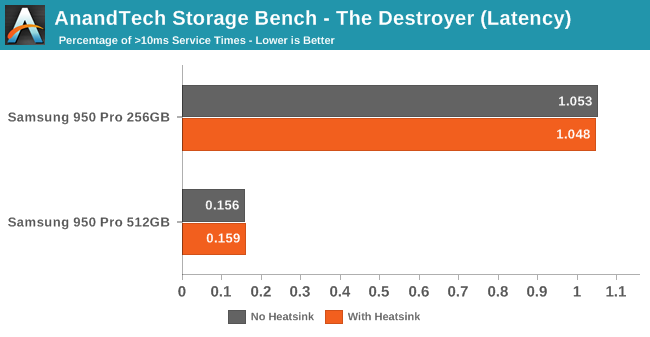The Angelbird Wings PX1 M.2 Adapter Review: Do M.2 SSDs Need Heatsinks?
by Billy Tallis on December 21, 2015 8:00 AM ESTAnandTech Storage Bench - The Destroyer
The Destroyer is an extremely long test replicating the access patterns of heavy desktop usage. A detailed breakdown can be found in this review. Like real-world usage and unlike our Iometer tests, the drives do get the occasional break that allows for some background garbage collection and flushing caches, but those idle times are limited to 25ms so that it doesn't take all week to run the test. Those pauses of up to 25ms are sufficient for the drive to complete a reasonable amount of background processing and return to idle, but they don't give the drive much time to cool off.


Average data rate on The Destroyer was essentially unchanged by the addition of the heatsink. The difference measured for average service time was slightly higher, but still insignificant. In both cases, the heatsink helped the 256GB drive and hurt the 512GB drive.


The frequency of latency outliers was also subject to some variation between runs, but its hard to attribute it to the influence of the heatsink since the effect was in the opposite direction for the two drives. With or without the heatsink the 950 Pro is posting great scores, and the 512GB drive outperforms the 256GB drive by a wide margin.










69 Comments
View All Comments
Ryan Smith - Monday, December 21, 2015 - link
That is actually correct. The drives are more consistent when they thermally throttle because the controller has plenty of time to catch up. Whereas with a heatsink they're running at full tilt, and sometimes the controller has trouble keeping things consistent.tipoo - Monday, December 21, 2015 - link
Huh, interesting.tipoo - Monday, December 21, 2015 - link
So why is the scenario the exact flip on the 256GB drive? Did it just finish the test sooner?Billy Tallis - Monday, December 21, 2015 - link
During thermal throttling, the 256GB was occasionally stuttering and dropping from 6k IOPS to 2k IOPS. That tanked the consistency score. The 512GB's performance regulation when thermally throttled was basically perfect—during steady state it never deviated from ~6k IOPS.Magichands8 - Monday, December 21, 2015 - link
I really don't get why so many people seem to love M.2 so much. Sure it's convenient for laptops but for just about anything else it's a severely limited form factor restricting capacity and adding heat issues while eating up precious expansion slot space on the motherboard. What I'd really like to see are U.2 SSDs with 10 times the capacity.nwarawa - Monday, December 21, 2015 - link
The performance is obvious plateauing with that heatsink, so it begs the question: what is good enough? I assume it's just the controller that needs to be cooled. Would one of those tiny chipset heatsinks with some thermal tape still see most, if not all, the benefit of this Angelbird heatsink?Billy Tallis - Monday, December 21, 2015 - link
Given sufficient airflow, I think one of those small heatsinks could get the job done. I don't think most M.2 slots or adapters put the drive in a position to receive that much airflow unless your case is already a serious wind tunnel.damianrobertjones - Monday, December 21, 2015 - link
"The M.2 form factor has quickly established itself as the most popular choice for PCIe SSDs in the consumer space. "How do you know this? I'd still rather buy a 950 Pro 2.5" than an M.2. (I do own both though)
moozooh - Monday, December 21, 2015 - link
"PCIe to M.2 adapter"Shouldn't it be "M.2 to PCIe adapter"? Since, you know, it adapts an M.2 device to a PCIe slot but not the opposite.
Billy Tallis - Monday, December 21, 2015 - link
I was looking at it as making a PCIe slot into an M.2 slot into which you'd insert the drive, as opposed to thinking of it as something modifying the drive. I can see how a consumer pairing it with a particular drive would take the other perspective, but to me the adapter is the permanent part of the testbed and the drives are transient occupants.